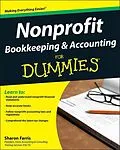Your hands-on guide to keeping great records and keeping your nonprofit running smoothly
Need to get your nonprofit books in order? This practical guide has everything you need to know to operate your nonprofit according to generally accepted accounting principles (GAAP) -- from documenting transactions and budgeting to filing taxes, preparing financial statements, and much more. You'll see how to stay organized, keep records, and be prepared for an audit.
* Begin with the basics -- understand common financial terms, choose your accounting methods, and work with financial statements
* Balance your nonprofit books -- set up a chart of accounts, record transactions, plan your budget, and balance your cash flow
* Get the 4-1-1 on federal grants -- find grants and apply for them, track and account for federal dollars, and prepare for a grant audit
* Stay in good standing with Uncle Sam -- set up payroll accounts for employees, calculate taxes and deductions, and complete tax forms
* Close out your books -- prepare the necessary financial statements, know which accounts to close, and prepare for the next accounting cycle
* Know what to do if you get audited -- form an internal audit committee, follow IRS rules of engagement, and keep an immaculate paper trail
Open the book and find:
* The difference between bookkeeping and accounting
* How to maintain a manual or computer record-keeping system
* Ten vital things to know when keeping the books
* Do's and don'ts of managing federal grant money
* How to prepare for an audit of your financial statements
* IRS Form 990 good practices
* The most common errors found during nonprofit audits
* How to figure out employee payroll deductions and taxes
Autorentext
Sharon Farris has been involved in the grants industry for more than ten years. She is the president of Farris Accounting & Consulting Training Services (FACT$) as well as the former president of the American Association of Grant Professionals (AAGP) Montgomery.
Inhalt
Introduction 1
About This Book 1
Conventions Used in This Book 2
What You're Not to Read 2
Foolish Assumptions 3
How This Book Is Organized 3
Part I: Accounting and Bookkeeping Nonprofit Style 3
Part II: Balancing Your Nonprofit Books 4
Part III: Accounting for Nonprofit Situations 4
Part IV: Wrapping Up the Books 4
Part V: The Part of Tens 4
Icons Used in This Book 5
Where to Go from Here 5
Part I: Accounting and Bookkeeping Nonprofit Style 7
Chapter 1: The Nuts and Bolts of Nonprofit Bookkeeping and Accounting 9
Getting Started with Your Nonprofit's Books 10
Identifying the difference between bookkeeping and accounting 10
Picking your accounting method 11
Understanding the basic terms 12
Adhering to GAAP 15
Keeping a paper trail 16
Auditing 101: It's a GAAS! 16
Making Sure Your Books Are Balanced 17
Establishing a chart of accounts 17
Tracking transactions 17
Developing a budget 18
Staying within the lines: Compliance 18
You're in the Money: The Lowdown on Federal Grants 19
Gleaning some grant basics 19
Following the rules 20
Going through a grant audit 20
Paying Uncle Sam: Employee Payroll Taxes 21
Getting a Grasp on Financial Statements 21
Figuring Out Where Your Nonprofit Is: Five Important Questions 23
Chapter 2: Starting with Basic Bookkeeping and Accounting 25
Understanding Bookkeeping and Accounting 25
What's the difference between bookkeeping and accounting? 26
Defining some common financial terms 27
Finding the Right People to Manage the Books and Monitor the Finances 29
Considering a bookkeeper or an accountant 30
Doing it yourself 31
Opting for a fiscal sponsor or agent 31
Outsourcing the job 32
Hiring an independent auditor 33
Choosing Your Accounting Method 33
Keeping track of the cash 34
Accrual basis of accounting 34
Running Numbers on Your Assets 35
Evaluating assets by original cost or fair market value 35
Grasping depreciation methods 36
Keeping an Eye on Your Assets 39
Protecting your nonprofit's physical assets 40
Setting internal controls 40
Chapter 3: Introducing Financial Statements 43
The Lowdown on Financial Statements: Why They're Important 43
Seeing the benefits of tracking the money 45
Who uses these statements 45
Using Financial Statements to Your Advantage 47
Assist with grant proposals 47
Allow you to track donations 48
Track nonprofit activities 48
Indicate lawsuits: Contingent liabilities 49
Identifying the Financial Statements 49
Reading the statement of activities 49
Working with the statement of financial position 52
Developing the cash flow statement 52
Grasping the statement of functional expense 55
Documenting the notes to the financial statements 55
Chapter 4: Keeping Good Records: Using a Manual System or Computer System 59
Going the Manual or Computer Route? 59
Choosing a Manual System 61
Knowing the pros and cons 61
Eyeing the parts of a manual system 62
Trying Excel: The Easy Computer Route 63
Breaking down the spreadsheet 64
Converting your manual system into a spreadsheet 65
Naming Other Available Software66
QuickBooks67
Microsoft Offi ce Accounting 67
Peachtree Accounting 68
Ensuring Your System Is Secure 69
Firewalls and virus scanners 69
User privileges and fi le sharing 70
Miscellaneous security programs 71
Backing Up Your System 71
Part II...
